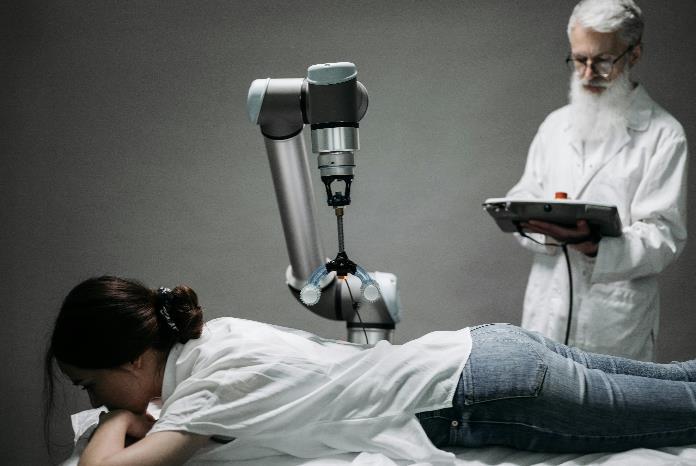
International Research Journal of Engineering and Technology (IRJET) e-ISSN: 2395-0056
Volume: 12 Issue: 04 | Apr 2025 www.irjet.net p-ISSN: 2395-0072


International Research Journal of Engineering and Technology (IRJET) e-ISSN: 2395-0056
Volume: 12 Issue: 04 | Apr 2025 www.irjet.net p-ISSN: 2395-0072
Suryansh Garg
Undergraduate Student, Dept. of Science and Computing, Chandigarh Business School of Administration Landran, Mohali, Punjab, India ***
Abstract - A major development in artificial intelligence (AI), reinforcement learning (RL) lets robots learn on their own by means of experience and error. The integration of artificial intelligence and reinforcement learning in robotics is investigated in this work together with their applications, related difficulties, and future possibilities. We show how RL improves robotic performance and adaptability by analyzing industrial automation, autonomous vehicles, and healthcare robotics. While suggesting future directions of research in this field, the paper also addresses important challenges including sample efficiency, the exploration-exploitation dilemma, and real-world adaptability.
Key Words: ArtificialIntelligence,ReinforcementLearning, Robotics, Robotic Performance, Industrial Automation, SampleEfficiency
Design,construction,andprogrammingofmachinesableto perform different tasks constitute robotics. Robots have traditionally been pre-programmed to follow set instructions,sorestrictingtheircapacitytochangewiththe times. But thanks to artificial intelligence especially Reinforcement Learning robots can now learn from experience, hone their behavior and over time maximize theirperformance.Likehumanlearning,RLhelpsrobotsto independently explore their surroundings, learn from rewardsandpenalties,andmakedecisions.
Thispaperinvestigatesusingaqualitativeandexploratory researchapproachtheintegrationofartificialintelligence, more especially reinforcement learning (RL), in robotic systems.Themethodcallsforacarefulreadingofacademic publications,businessstudies,andcasestudiesshowingthe applications, benefits, and limitations of reinforcement learning in robotics. To assure a thorough and in-depth knowledge,sourceswereselectedfromeminentconferences andpublicationsinthefieldsofmachinelearning,robotics, and artificial intelligence. Three main application areas healthcare robotics, autonomous cars, and industrial automation where reinforcement learning has clearly shownimpact werethefocusofthereview.
Moreover,acomparisonofseveralreinforcementlearning techniques and their performance in real-world robotics environmentswasdone.Thesecomprisemethodsincluding Q-learning, Policy Gradient, Deep Q-Networks (DQN),
SoftActor-Critic(SAC).Analyzedweresimulationresultsand empirical data in order to identify trends, challenges, and areas of future research direction. This methodological framework supports the objective of including present difficulties, acknowledging current knowledge, and suggesting future directions for the application of reinforcementlearninginrobotics.
Inthemachinelearningparadigmknownasreinforcement learning,anagentinteractswithanenvironmentandlearns fromfeedback thatofrewardsorpenalties.Bymeans of repeated interactions, this method helps robots to create ideal decision-making strategies, so enhancing their efficiencyandeffectivenessindifficulttasks.
RL improves robotic efficiency in manufacturing and logistics when handling jobs including quality control, sorting, packaging, and product scanning. For inventory controlandoperationsimplification,forexample,Amazon's warehousesuseRL-poweredrobots.Byalwayslearningand improving their performance, these robots help to lower mistakesandraiseoutput.

Figure- 1 : Showcase of a robotic arm based on reinforcementlearningsortingobjectsina manufacturing settingtoraiseefficiencyandlowererrorrates.

International Research Journal of Engineering and Technology (IRJET) e-ISSN: 2395-0056
Volume: 12 Issue: 04 | Apr 2025 www.irjet.net p-ISSN: 2395-0072
Self-drivingcarsuseRLtomakedynamicenvironmentrealtimedecisions. Byallowing autonomous carsto maximize braking,acceleration,andnavigationtechniques,RL-based modelshelptoimproveefficiencyandsafetybyReal-world pathplanning,obstacleavoidance,andtrafficmanagement are improved by companies including Tesla and Waymo usingRLtechniques.

Figure-2:Anexampleshowinghowreinforcementlearning methods direct autonomous cars in real-time navigation, obstacleavoidanceanddecision-making.
Bylettingrobotsincreaseaccuracyandadaptability,RLhas also transformed robotic-assisted surgeries. RL-based surgicalrobotslearnfrompastoperationsandimprovetheir methods rather than only following pre-programmed instructions. Notable developments in China and other nations have shown how well RL-driven surgical robots performdifficultmedicaloperationswithincreasedaccuracy andminimumhumaninvolvement.

Figure-3:Visualizationofaroboticsurgicalsystemimproved by reinforcement learning showing accuracy in difficult operationswithlesshumaninvolvement.
5. Challenges
5.1 Sample Efficiency
Extensivetrial-and-errorlearningiswhatRLcallsfor,andit canbecostlyandtime-consuming.Trainingrobotsinphysical surroundings requires costly hardware and extended learningtimes,hencewithouteffectivesimulationmethods RLislessfeasibleforpracticaluses.
Balancing exploration that is, trying new actions to find better solutions and exploitation that is using known strategiestoreachoptimalresults isabasicdifficultyinRL. Arobotlearningtowalk,forexample,mustinvestigatemany movement patterns before deciding on the best gait. Maximising learning efficiency depends on findingthepropermix.
Since everything is under control in computer games, RL modelsperformremarkablythere.Therealworldismessy, though, with unanticipated objects like shadows or poor illumination. Since RL models grow from experience, they findsurprisestheyhaveneverencounteredchallenging.That makes working outside of controlled surroundings difficultforthem.
Multipleroboticagentssometimeshavetocooperateorrun inparallelincomplicatedsettings.Bylettingseveralagents learn concurrently, either cooperatively or competitively, multi-agent reinforcement learning (MARL) broadens conventional RL frameworks. Every agent becomes more dynamic and context-aware in its decision-making by learningtoadjustnotonlytothesurroundingsbutalsotothe actionsofotheragents.
SignificantusesofMARLareinmulti-robotsurgicalsystems, warehouseautomation,autonomousdronefleets,andswarm robotics.Forinstance,inlogistics,robotstrainedwithMARL can effectively allocate duties, prevent accidents, and maximizerouteplanning.Inhealthcare,multi-armsurgeries canbeperformedmorepreciselyandsafelywiththehelpof cooperativeMARL.
Important approaches are communication-aware techniques,rewardshapingforcooperativeobjectives,and centralizedtrainingwithdistributedexecution.Especiallyin dynamic and uncertain settings, these systems guarantee scalability,adaptability,andresilienceinroboticsystems.

International Research Journal of Engineering and Technology (IRJET) e-ISSN: 2395-0056
Volume: 12 Issue: 04 | Apr 2025 www.irjet.net p-ISSN: 2395-0072
Thedifficultyintransferringpolicieslearnedinsimulationto actualapplications achallengeknownasthe"sim-to-real gap" is one of the main drawbacks of reinforcement learning in robotics. Though they sometimes lack the complexity and unpredictability of the physical world, simulatedenvironmentsoffersafe,affordableplatformsfor trainingrobots.Modelstrainedonlyinsimulationtherefore oftenunderperformwhenusedinrealsituations.
Many methods have appeared to close this gap. Domain randomizationmakesmodelsmoreresilientbyintroducing variability in the simulation including lighting conditions, textures,andobjectdynamics.Domainadaptationtechniques fine-tune pre-existing policies on actual data. Improving generalizability is also being more dependent on physicsinformed simulators that closely replicate real-world dynamics.
Furthermore,transferlearningandfine-tuningletrobotsfit pre-trained models to actual settings with less testing and trial.Inindustrialautomationandsurgicalrobotics,where real-worldmistakescanbeexpensiveorhazardous,sim-toreal methods are especially helpful. RL systems get more feasibleforlarge-scaledeploymentbyclosingthisrealitygap
Although autonomous learning is a key benefit of reinforcement learning, human direction can help it much more.Human-in-the-loopreinforcementlearning(HIL-RL) allows robots to fit more closely with human values and expectationsbyincludinghumaninput,demonstrations,or interventions into the learning process.
In safety-critical or highly personalized areas like elderly care,surgery,anddomestichelp,thisisespeciallycrucial.By using expert demonstrations and human evaluations, techniques such as reinforcement learning from human feedback(RLHF),imitationlearning,andpreference-based reinforcementlearningletmachineslearnmorequicklyand safely.
HIL-RL can shorten training time, prevent catastrophic mistakesduringexploration,andincreaseuserconfidencein roboticsystemsinpracticaluse.Combininghumanintuition with data-driven learning allows for better generalization andadaptability,makingRL-poweredrobotsmoreeffective anduser-friendlyinpracticalapplications.
9. Future Potential
RoboticscouldbegreatlyadvancedbytheintegrationofRL with other artificial intelligence disciplines including computer vision and natural language processing. Future studies might concentrate on using transfer learning to increasesampleefficiency,soallowingrobotstogeneralise
knowledgeovermanyfields.Furthermoreimprovingrobotic decision-makingcapacityisthecreationofhybridartificial intelligencemodelscombiningsupervisedlearningwithRL.
Consolidation Autonomous learning and decision-making made possible by learning is changing robotics. Although problems including sample inefficiencies, explorationexploitationtrade-offs,andreal-worldadaptabilityremain, continuous research and technical developments are opening the path for more intelligent and autonomous roboticsystems.Withongoingdevelopment,RLislikelyto become indispensable in many different sectors of roboticsgoingforward.
1. Sutton, R. S., & Barto, A. G. (2018). Reinforcement Learning:AnIntroduction(2nded.).MITPress.
2. Haarnoja,T.,Zhou,A.,Abbeel,P.,&Levine,S.(2022). SoftActor-Critic:Off-PolicyMaximumEntropyDeep Reinforcement Learning with a Stochastic Actor. IEEE Transactions on Neural Networks and LearningSystems,33(7),3041-3056.
3. Kumar, A., Singh, A., & Garg, D. (2023). Reinforcement Learning for Adaptive Control in Robotics:ASurvey.JournalofIntelligent&Robotic Systems,108(1),45-66.
4. Schrittwieser, J., Antonoglou, I., Hubert, T., Simonyan,K.,&Silver,D.(2021).MasteringAtari, Go, Chess, and Shogi by Planning with a Learned Model.Nature,589(7844),603-609.
5. Zhu, H., Hu, J., Yu, J., & Xu, W. (2023). Deep Reinforcement Learning for Real-world Robotic Applications: Challenges and Future Directions. RoboticsandAutonomousSystems,168,104752.
6. OpenAI,DeepMind,&BerkeleyAIResearch.(2022). RLHF: Reinforcement Learning from Human Feedback for Safer AI. arXiv preprint arXiv:2204.05862.
7. James,S.,Wohlhart,P.,Kalakrishnan,M.,Kalashnikov, D., Irpan, A., Ibarz, J., Levine, S., Hadsell, R., & Bousmalis, K. (2018). Sim-to-Real via Sim-to-Sim: Data-efficientRoboticGraspingviaRandomized-toCanonical Adaptation Networks. arXiv preprint arXiv:1812.07252.
8. Tan, J., Zhang, T., Coumans, E., Iscen, A., Bai, Y., Hafner,D.,Bohez,S.,&Vanhoucke,V.(2018).Sim-toReal: Learning Agile Locomotion For Quadruped Robots.arXivpreprintarXiv:1804.10332.

International Research Journal of Engineering and Technology (IRJET) e-ISSN: 2395-0056
Volume: 12 Issue: 04 | Apr 2025 www.irjet.net p-ISSN: 2395-0072
9. Goecks, V. G. (2020). Human-in-the-Loop Methods for Data-Driven and Reinforcement Learning Systems.arXivpreprintarXiv:2008.13221.
10. Zhao,W.,PeñaQueralta,J.,&Westerlund,T.(2020). Sim-to-Real Transfer in Deep Reinforcement Learning for Robotics: A Survey. arXiv preprint arXiv:2009.13303.
11. Wu,J.,Huang,Z.,Huang,C.,Hu,Z.,Hang,P.,Xing,Y.,& Lv, C. (2021). Human-in-the-Loop Deep Reinforcement Learning with Application to Autonomous Driving. arXiv preprint arXiv:2104.07246.
12. Chaffre,T.,Moras,J.,Chan-Hon-Tong,A.,&Marzat,J. (2020). Sim-to-Real Transfer with Incremental Environment Complexity for Reinforcement Learning of Depth-Based Robot Navigation. arXiv preprintarXiv:2004.14684.
13. Jonnarth, A., Johansson, O., & Felsberg, M. (2024). Sim-to-Real Transfer of Deep Reinforcement LearningAgentsforOnlineCoveragePathPlanning. arXivpreprintarXiv:2406.04920.
14. Salimpour, S., Peña-Queralta, J., Paez-Granados, D., Heikkonen,J.,&Westerlund,T.(2025).Sim-to-Real Transfer for Mobile Robots with Reinforcement Learning: From NVIDIA Isaac Sim to Gazebo and RealROS2Robots.arXivpreprintarXiv:2501.02902.
15. Thompson,C.(2017).IfYouWantaRobottoStop ScrewingUp,HoldItsHand.WIRED.Retrievedfrom https://www.wired.com/story/if-you-want-a-robotto-stop-screwing-up-hold-its-hand/
16. Guzman, M. (2019). The WIRED Guide to Robots. WIRED. Retrieved from https://www.wired.com/story/wired-guide-torobots/
17. Dunleavy,R.(2025).WatchEerieVideoofHumanoid Robot'Army'MarchingNaturally,ThankstoaMajor AI Upgrade. Live Science. Retrieved from https://www.livescience.com/technology/robotics/ watch-eerie-video-of-army-of-humanoid-robotsmarching-naturally-thanks-to-a-major-ai-upgrade/
18. Thompson, J. (2024). Artificial Intelligence Breakthroughs Create New 'Brain' for Advanced Robots. Financial Times. Retrieved from https://www.ft.com/content/bea9df71-371c-40459cb4-64c22789bf7b
19. Greenberg,A.(2025).BostonDynamicsLedaRobot Revolution. Now Its Machines Are Teaching
Themselves New Tricks. WIRED. Retrieved from https://www.wired.com/story/boston-dynamicsled-a-robot-revolution-now-its-machines-areteaching-themselves-new-tricks/
20. Wang,H.,Zhang,Y.,Liu,Y.,&He,Z.(2022).ADigital Twin-Based Sim-to-Real Transfer for Deep Reinforcement Learning-Enabled Industrial Robot Grasping. Robotics and Computer-Integrated Manufacturing,74,102365.
21. Chaffre,T.,Moras,J.,Chan-Hon-Tong,A.,&Marzat,J. (2020). Sim-to-Real Transfer with Incremental Environment Complexity for Reinforcement Learning of Depth-Based Robot Navigation. arXiv preprintarXiv:2004.14684

Suryansh Garg is a final semester student in BSc Artificial intelligenceandMachineLearning at CGC Landran. He is passionate aboutresearchwithfuturegoalof industrialinnovations.